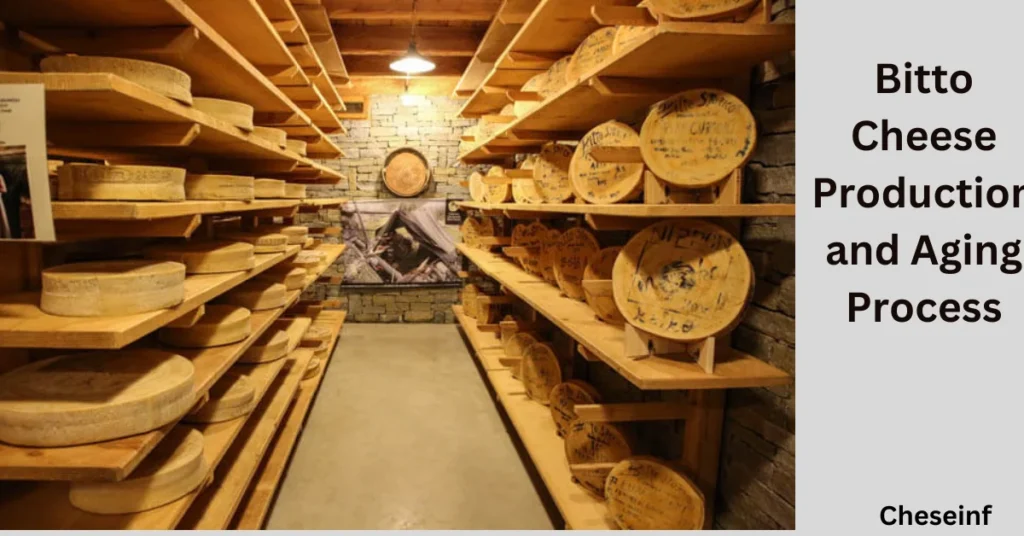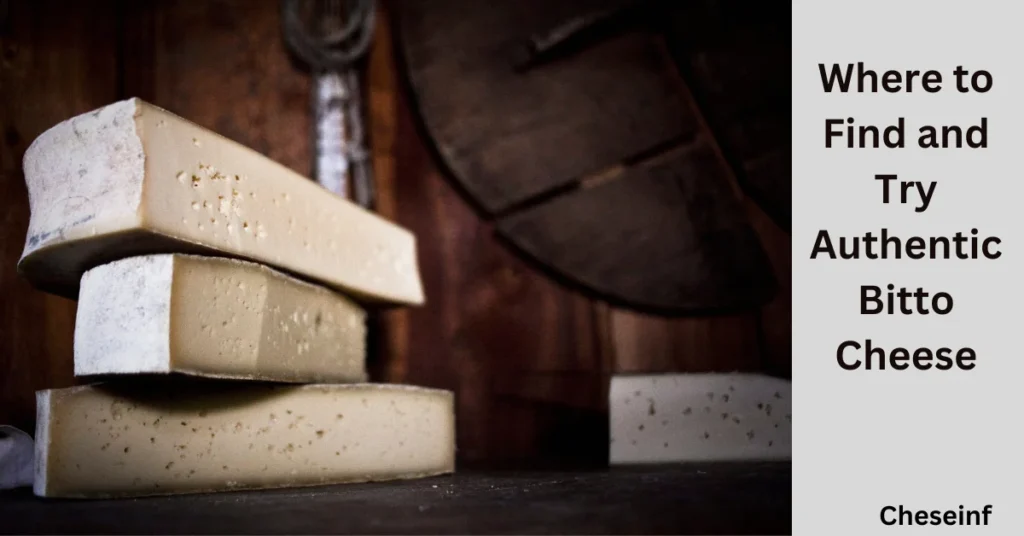You walk into a Bitto shop and immediately spot a funky wheel of Bitto Cheese with a natural rind. It has small holes and a strong, earthy aroma that captivates you. What is this intriguing cheese? It’s called Bitto, from the Italian Alps.
Bitto has been made the same way since the 12th century, with a rich history that matches its flavor. Though it’s not well-known outside northern Italy, once you taste its complex nuttiness, you’ll want to share this hidden gem with all your foodie friends. Get ready to discover the delicious world of Bitto cheese!
An Introduction to Bitto Cheese:
Bitto is a cheese from Italy with a history that goes back over 1,000 years. It comes from the Valtellina valley in Lombardy and is made from raw cow’s milk. Bitto cheese is aged for at least 70 days, which gives it a hard, crumbly texture and a tangy, nutty taste
Production and Aging:
- Bitto is produced using milk from cows that graze on the alpine pastures of Valtellina.
- The milk is coagulated, shaped into wheels, and aged in stone huts for at least 70 days.
- As Bitto ages, it develops a hard, granular texture and an intense, savory flavor with notes of nuts and grass.
- Aged Bitto, called Stravecchio, is aged for a minimum of 2 years and up to 10 years, resulting in a very hard, crumbly cheese with a robust, tangy flavor.
Pairing and Enjoying Bitto:
Bitto pairs well with the hearty red wines of Valtellina, especially Nebbiolo-based wines like Valtellina Superiore. It is also excellent with dark beers like stouts and porters. Bitto is often grated over pasta, polenta, and risotto in Valtellina. Aged Bitto is best enjoyed on its own, shaved into thin slices. Its complex flavor needs little accompaniment.
Whether young or aged, Bitto cheese is a delicious introduction to the alpine cheeses of Northern Italy. With its rich history, artisanal production, and full, savory flavor, Bitto deserves a place among the world’s greatest cheeses. Discovering Bitto is discovering a piece of Italian culture, tradition, and identity.
The History and Origins of Bitto Cheese:
Bitto cheese has been produced for centuries in the Valtellina valley of Northern Italy. Legend has it that Bitto was first created by farmers in the Middle Ages as a way to preserve excess milk produced during the summer months.
The production of Bitto cheese is a long and laborious process. Cow’s milk from two milkings is mixed together and left to sit until the next morning. Rennet is then added to coagulate the milk into curds. The curds are broken up and heated, then poured into molds.
The cheese rounds are aged for a minimum of 70 days, up to 10 years for the Stravecchio variety. As Bitto ages, it develops a hard, crumbly texture and nutty, tangy flavor due to the growth of flavorful microbes and molds on the rind. Connoisseurs consider Stravecchio Bitto a delicacy and are willing to pay high prices for an aged wheel.
- Bitto receives its distinctive aroma from the grass and wildflowers upon which the cows graze in the Alpine meadows.
- The cows are milked only in the summer when the wild grasses and flowers are most fragrant.
- This seasonal production and connection to the land is an important part of what makes artisanal Bitto cheese unique.
If you have the opportunity to try Bitto cheese, take the time to appreciate its complex flavor and texture, knowing you’re enjoying a historic product that represents an Alpine tradition spanning over 1,000 years. Bitto is a culinary time capsule and a delicious link to the pastoral heritage of Northern Italy.
Bitto Cheese Production and Aging Process:

The production of Bitto cheese is an artisanal process that has been passed down for centuries in the Valtellina valley of northern Italy. To make Bitto, dairy farmers first collect milk from cows that graze on the Alpine pastures surrounding the valley. The milk is then heated and mixed with rennet to form curds. Next, the curds are pressed into large wheels and aged for a minimum of 6-12 months.
Production:
- After collecting the milk, it’s heated to 90-95°F which helps the curds form better.
- Rennet is then added, which contains enzymes to separate the curds (solids) from the whey (liquid).
- The curds are cut into small pieces, cooked further, and then pressed into large wheels.
- These wheels weigh up to 66 pounds! The wheels are salted and aged in specially constructed aging cellars with conditions ideal for developing the cheese’s complex flavors.
Aging:
The aging process is key to developing the hard, crumbly texture and nutty, floral flavors Bitto is known for. As the cheese ages, natural biochemical changes occur due to exposure to oxygen and ambient molds. The aging time listed is just a minimum—some Bitto wheels are aged 3-5 years or longer. As the cheese ages, it loses moisture which leads to its characteristic crumbliness. Peroxide compounds also form, resulting in floral, fruity aromas.
Bitto’s production and aging is truly an art form that has been perfected over centuries. The end result is a cheese that is subtly sweet, with notes of hay and herbs and a slightly bitter finish. No wonder Bitto has been designated a traditional food product and recognized by the Ark of Taste as an important part of Italy’s gastronomic heritage. Trying an aged wedge of Bitto cheese is a delicious way to experience history.
The Unique Flavor, Texture and Uses of Bitto Cheese:
Bitto cheese has a very distinct flavor and texture unlike any other cheese. Its flavor is nutty, tangy and slightly sweet with caramel undertones. As Bitto ages, these flavors become more pronounced and complex. The texture is hard and crumbly when young but becomes soft, granular and almost flaky as it matures.
A Cheese Like No Other:
Bitto is made from raw cow’s milk from two local breeds of cattle, giving it a one-of-a-kind taste. The milk is coagulated and the curds are cooked and pressed. The cheese is then aged for a minimum of 70 days up to 10 years. This long aging process is what gives Bitto its signature tang and nutty, caramelized flavors. Bitto also develops tiny cracks and fissures as it ages, allowing flavors to intensify.
Versatile and Delicious:
Bitto’s unique qualities make it ideal for eating on its own, whether young or aged. Its crumbly yet creamy texture is perfect for shaving or grating over pasta, risotto, polenta and soup. Bitto also melts well and is great in fondue or on pizza. For an appetizer, top crostini with Bitto, walnut pesto and a drizzle of honey.
A Protected Designation of Origin:
Bitto cheese has Protected Designation of Origin (PDO) status, meaning it can only be produced in a specific geographical region using traditional methods. Bitto PDO specifies that the cheese must be made from the raw milk of cows grazing in the Valtellina valley of Lombardy, Italy. This ensures an authentic product with qualities that can’t be replicated anywhere else.
From its distinct flavor to its versatility and PDO status, Bitto cheese is truly one of a kind. Once you discover Bitto, you’ll never look at cheese the same way again. Buon appetito!
Where to Find and Try Authentic Bitto Cheese:

Bitto cheese is primarily produced in the Valtellina valley of northern Italy, located in the Lombardy region. This artisanal cheese has been made for centuries in the small mountain villages scattered along the valley. For the authentic experience, head to this picturesque area to sample Bitto straight from the source.
Local Cheese Shops:
Dotted throughout the Valtellina valley are small family-run cheese shops, called latterie in Italian, that sell locally-made Bitto. Drop by and you’ll find giant wheels of Bitto aging on wooden shelves and tables.
The shop owners are extremely knowledgeable about their products and can offer tastings of different ages and varieties of Bitto. They’ll happily share suggestions for the perfect wine to pair it with as well.
Farmers Markets:
- Weekly farmers markets, called mercati, are held in many towns in Valtellina, especially on weekends.
- Here you’ll find local cheesemakers selling freshly made Bitto, as well as other regional specialties like bresaola (air-cured beef), pizzoccheri pasta, and chestnuts.
- Chat with the vendors to learn about their cheesemaking process and pick up some samples.
- The markets often have a lively, social atmosphere where locals go to catch up with friends over a glass of wine or coffee.
Agriturismos:
For an authentic farm-to-table experience, stay at an agriturismo—a working farm that provides meals and accommodation, often in a rustic setting. Many agriturismos in Valtellina produce their own Bitto cheese, as well as other foods like wine, olive oil, and preserves.
Meals will feature homemade Bitto in traditional dishes like pizzoccheri, polenta, and gnocchi. You may even get a tour of the cheesemaking facilities and a chance to see how Bitto is produced. An agriturismo stay is a wonderful way to immerse yourself in the local culture, cuisine and natural scenery.
From the source in Valtellina to your table, Bitto cheese is meant to be appreciated for its complex flavors that reflect the territory and traditions of northern Italy. Seek out authentic Bitto and enjoy!
Conclusion:
So, there you have it—a quick look into the unique and delicious world of Bitto cheese. It’s amazing how such a small region in Italy can create something so special! Hopefully, you’ve discovered a new type of cheese to enjoy.
Now that you’re intrigued, why not go and try this tasty treat? Enjoy it on pizza, in fondues, grated over pasta, or simply sliced on its own. No matter how you try it, you’ll savor every bite of this authentic Italian delicacy, crafted for centuries in the pristine mountains of Lombardy. Expand your cheese horizons and let Bitto delight your taste buds!

where we’re dedicated to all things cheese! From easy DIY recipes to exploring different cheese types, we’re here to inspire and empower cheese lovers worldwide. Join us as we celebrate the joy of cheese-making and discovery
